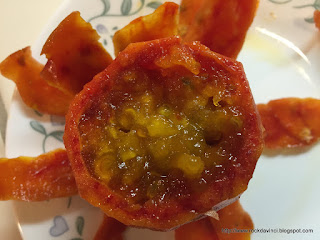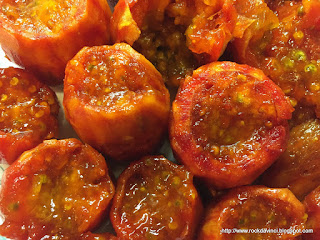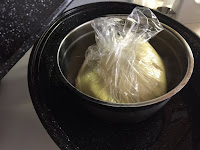HOKKAIDO MILK LOAF - Polly’s with Matcha 3/15/2017
Basic recipe by Yvonne C. “65’CTang Zong Bread” book I purchased.
2 LOAF PANs - Size 12?? -
I used one Pullman loaf pan with Cover 9 x 4 x 4 inch or 28.8 x 10.1 x 10.1 cm.
And a full size disposable aluminum loaf pan with Cover 11.5 x 5.5 x 3.5 inch.
Ingredients:
Group A:
540 g - Bread Flour or Natural White - Wheat Montana
Unbleached Non GMO All Purpose Flour
68 g - Organic cane
sugar
6 g ( orig: 8 g) - Kosher Salt
11 g Dry Yeast
Group B:
86 g whole eggs (about 2 small eggs)
59 g Butter - room temp
54 g Milk
9 g natural Milk flavoring?? I did not use... I suppose the commercial baker use this to enhance the aroma?? (Yak!)
To make 65'C Roux or Tang Zong:
184 g Tang Zong (Roux) -
Polly's modified measurement: 200 g water + 40 g Flour with Matcha.
Premix 150 g flour with 12 g Natural Matcha - Not for the smoothie type with food color - use the real stuff, then measure out 40 g flour with Matcha.
Group C:
49 g Sour Cream (unsalted fermented milk butter - is what it
says in the book)
1 egg wash - I used whole egg, but removed some most of the egg white.
Add 1 tsp of milk
To make Roux -TANG ZONG 65'C
In a small pot, add 40 g pre-shifted Match flour. Add about 1/4 C of 200 g water and whisk. This method avoid lumps compared to when you pour all the liquid into the dry. As the mixture smooth out, add some more water, and eventually all.
Cook over a low heat with Thermometer handy.
Stir continuously with a whisk or heatproof spatula.
Take the temp every few seconds.
It will thicken from the edge quickly. Keep stirring the edge in or it will form lumps!
As soon as the temperature get close to 65'C, the mixture would thicken... rather quickly, so keep stirring and remove the pot off the stove top immediately. Keep covered (with plastic film - hopefully non leaching pta or other yaky chemical) to store to avoid skin to form. I
just let it set aside to cool while I got all the Group A ingredients
measured into the mixer.
Weigh out 184 g of Roux
There should be a bit more than 184 g completed roux.
Mixing Dough:
Add all Group A ingredients into a mixer bowl.
Hand
Whisk them together first.
Add Group B. Hand mix
with spatula
Add Group C.
Hand mix
with spatula.
Why hand mix? - If you love your mixer, hand mix at the beginning to avoid fine flour particles to settle into your mixer's enclosed motor unit. Believe me, they will get in there overtime.
With Dough hook,
at speed one - Stir mode, mix the ingredients 30 to 45 sec.
(Kneading time with Kitchen Aid Professional 5 Plus model: 30 min. - 10 min interval check.)
Change to speed #2.
Knead for 10 min.
Stop and
check.
The dough is quite well
formed.
Leaving the bowl’s side with no
flour.
Knead for another 10 min., Check.
Knead another 10
min.
Because of the Egg and butter in the dough, the dough would
not form the 'normal' elasticity.
But take time to knead until a good elasticity is formed to bake
into a nice pulled crumb.
Place in slightly oiled plastic bag for 1st rise.
I used Turkey roasting pan with cover filled with hot water (about 120'F or feel quite warm when your hand is dipped in without burning) to simulate the bread proofing box.
1st Rising:
About 40 min in 28’C, 75% moisture. A Large Turkey roast pan filled with hot
water. Placed large metal bowl with
dough in oiled plastic bag placed in the water with roast pan cover. After 40 min, the dough doubled in size on
time.
Portioning:
Divide dough into 4 - 265 g each My portion is about 261 g each.
Bench Rest: 15 min. Up to this point, everything went accordingly
Form
- no problem forming
Last Rise in baking bread mold: 8 min - in room temp 38’C with moisture 85%.
The last rise is taking longer tan 8
min for the doughs to fill the bread mold as illustrated in the book’s. Extending the rise time to
15 min. covered in the Pullman bread pan in one and Buca’s pasta's to go pan with cover
in the other. Both lined with organic
parchment paper. Placed on open turkey
roast pan filled with hot water.
Inverted bowls inside at the bottom to hold the bread pans.
I can easily heat up the water when it becomes too cool. But Do Not leave it on no longer than 30 sec and do not leave kitchen.
At 13 min - the dough in Pullman bread pan has expanded to
almost touching each other.
The doughs in aluminum bread mold with cover from Buca pasta
delivery are still slow in rise, but it is rising.
*Checked at end of 15 min in bread molds over the hot water
in roasting pan.
The dough has not increased in double in size as shown in
the book illustration. The required temp
is 38’c with moisture 85% that I do not have.
At this time of rising in the mold, the oven is turn on to
350’F *Hoping the heat from oven would
help in rising in the pan
1. 15 min not rising much
2. 15 min rising well and very very close to touching
each other. Applied egg wash.
3. 15 min or 10
min? this is difficult. I heat up the water again in the roasting pan
with bread pans over it.
Perfect rise at 12
min. I thought - Doughs are touching each
other. Ready for baking. But after the baking, I realized that I should have let them rise the full 15 min.
Bake: Preheat
oven to 350’F - 150'C on top and 180’C on bottom - Bake 35 min.
I do not have the specialized bread oven. Just my large gas oven. So, know your oven's BTU.
Oven is filled with a pan of hot water under the mid bottom
rack in a brownie pan.
Baking rack at the mid section for baking when ready.
Since I do not have a
commercial oven that would emit heat 150’C on Top and 180’C on bottom. I have a pan of water with hot water in the
oven to simulate Hotness of the environment. Hmm... really?
When ready to bake, I removed the pan of water.
Result of baking in Pullman or covered bread mold for 35
min:
( I love taking pictures of food.)
It is so fluffy... and smell wonderful!
the large aluminum mold’s bread
showed a bit of under bake at the top and bottom. Either waited a full 3rd 15 min for the final
rise before baking could prevented it or baked for 8 more minutes?
The bread in Pullman mold also showed some ‘not full risen’
sign at the top and bottom.
However, overall, this is a great recipe to keep trying.
Wow. Only a small slice and you can feel the full packed taste and satisfaction.
Awesome sandwich bread!!
3/19/17 - Forget the 'bit dense' dough at the top or the bottom. After I toasted them, oh my goodness! they are light and delicious!





































































